Have You Any Wool?
Yes sir, yes sir three bags full!
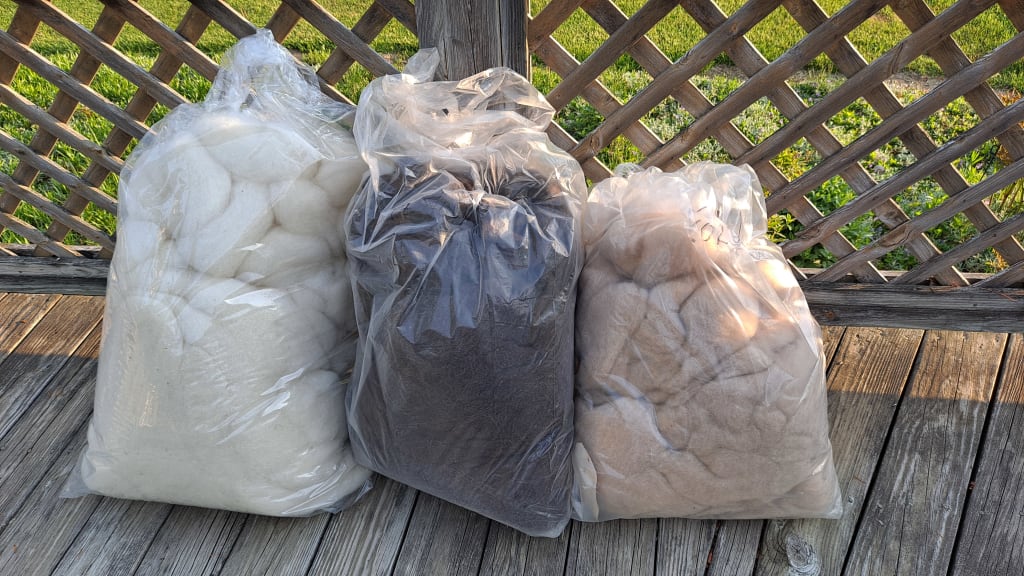
We have horses. Many of our friends have horses too. If you have horses, you most likely have a menagerie of other pets and farm animals. When the word got out to our horsey friends that I had taken up spinning as a hobby, I was suddenly inundated with fleece from my friend's barnyard buddies.

There is a learning curve when it comes to spinning. While I was voicing my frustration one day with my lack of success, my husband encouraged me to, "hurry up Ma or we won't have any clothes for the winter!" Making homespun fabric is quite a time consuming process. No wonder people of the past had so few clothes. The process of making fleece into yarn involves:
1. Sheering fleece from the sheep (or other animal)
2. Separating fleece into grades by coarseness
3. Washing the fleece to remove oils, dirt and foreign matter (not easy! you have to make sure you don’t turn it into felt)
4. Rinsing several times
5. Setting out to dry
6. Picking out any remaining debris
7. Smoothing out lumps and pulling the fiber apart
8. Dyeing if desired
9. Carding or combing the fiber so that all the fibers go in the same direction
10. Spinning the fiber into yarn or thread to use for weaving or knitting or crocheting

Nowadays, you can just take fleece to a woolen mill to have it processed. The finished product is called roving. The roving can be spun into yarn or used for other crafts such as felting and needle felting.
Unlike many crafts, once you get the hang of spinning, you can do it without looking at what you are doing and you can even carry on conversations with others while you are spinning. For this reason, spinning bees and spinning circles were very popular events hundreds of years ago. In the American colonies, women's spinning bees played an important role in protesting British taxes levied upon the colonists. Boycotts of items shipped from England were the best way to protest the taxes but that meant they had to have homemade substitutes for those products. One way the women of the New England colonies did this was to have spinning bees. Women would gather together and spin yarn and weave it into fabric. Spinning bees were considered an acceptable way for women to protest the British and voice their support for the rights of the colonies. In some cases, patriot spies even used buttons, sewn onto the woven fabrics, to hide secret messages.
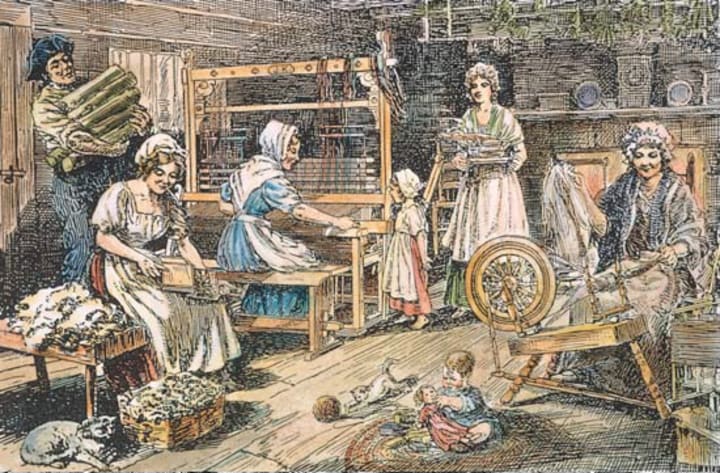
Spinning is a calming and soothing activity too; well, except when a frustrated husband wants a shirt for the winter. Spun yarn is categorized by "weight". Weight refers to the thickness of the yarn and ranges from lace to super bulky. There are seven different categories of yarn weights. Spinning fiber into a super fine weight yarn takes talent and I can honestly say, I'm not that talented. Since my yarn has lots of bumps and varying weights, I call it "artisan yarn" (that sounds impressive doesn't it?).
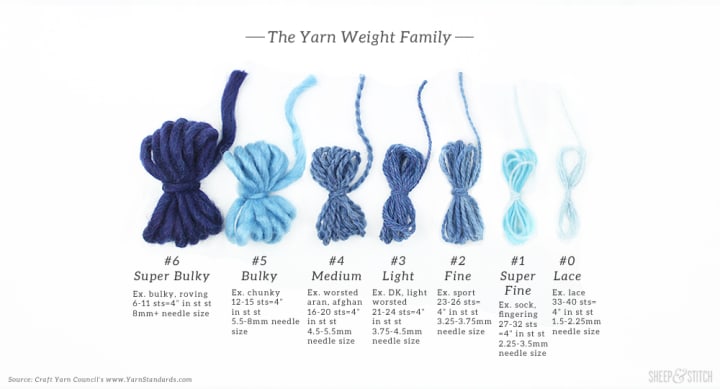
As soon as I began my spinning adventure, friends started sending me bags full of fleece. I received fleece from many different breeds of sheep. I also received alpaca, angora and cashmere goat. Even our Bearded Collie contributed to my spinning addiction. Dog’s hair must come from its undercoat, not the glossy overcoat, and it cannot be cut. It must be harvested with a brush, comb or rake.
Pretty soon I had more yarn than I knew what to do with. And balls of yarn are not like zucchini that you can leave on people's front porches under the cover of night. So, I started making things with all of the yarn. It's more acceptable, I think, to give gifts of hats and scarves rather than balls of yarn!
It didn't take long to realize that I had more roving than I could possibly spin into yarn so I needed to find ways to use the roving. That's when I discovered needle felting. Needle felting is a craft that involves repeatedly stabbing a barbed needle into a piece of roving in order to stiffen and shape it into the desired form. Unlike soothing your soul by spinning, needle felting allows you to take out your frustrations by stabbing needles into things. I decided that I had found the prefect combination of crafts based on my mood. Now I needed to find things to needle felt. Our son was the first recipient of my needle felting endeavor. Upon graduation from college, he accepted a position out of state and I decided he needed to take our dog and cat to keep him company - needle felted versions of course. Notice that the cat even has whiskers - trimmed with my Fiskars of course!

Soon Christmas was upon us and I thought, "hmm I think baby Jesus would like some four legged friends to keep him warm in the manger." So, I made needle felted versions of anything I could think of that would be in a barn and gathered around a manger....well, plus a fox because I like foxes.
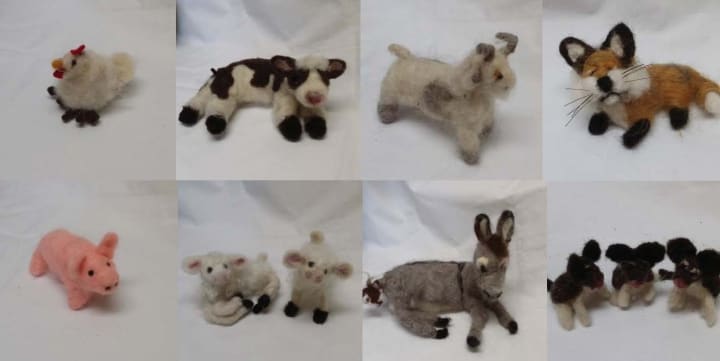
I still had lots of yarn and roving that needed to be put to use. I was at a boutique store and saw a little wool purse and I thought, "ah ha...I can do that!" Have you ever accidentally shrunk something made out of wool? Well this project involves shrinking something on purpose. So I crocheted purses out of wool yarn and felted them by shrinking them in the washing machine. I decided to use the roving I had too and needle felted a fox onto the front of a purse. The purse received many ooos and ahhs wherever I went and before I knew it, I had requests for purses with people's dogs, cats, birds and all sorts of things. A local store even asked me to make purses with their horse head logo.
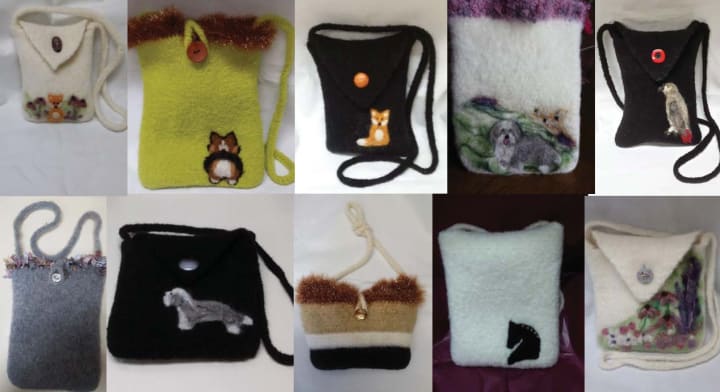
Time to make a business card to hand out when people asked about my purse - so I did! I partnered up with my fiber artist friend, Mary, and we were off and running selling fiber art projects and offering fiber art workshops. Her talent far exceeded mine so I was soon learning even more amazing things to do with fiber. If anyone had more yarn and fiber than I did, it was Mary! She has more talent in her baby finger than I could ever hope to have. She's never afraid to try something new. Mary is a real artist - she has a BFA degree and has her art in galleries. Her attitude is that nothing is wrong; that's just how it turned out. Now that's an attitude that works for me!
One day I was out window shopping and saw some gorgeous, very expensive scarves made of silk and wool so, I took a picture and asked Mary about them. "That's nuno felting", she said, "let's give it a try and offer a workshop!" The technique bonds fiber into a sheer fabric by using a soap and water solution and then lots of rolling and kneading - like making bread. The fibers can completely cover the background fabric or they may be used as a decorative design that allows the backing fabric to show. I don't know what inspires people to come up with ideas like this but wow, how clever and beautiful.
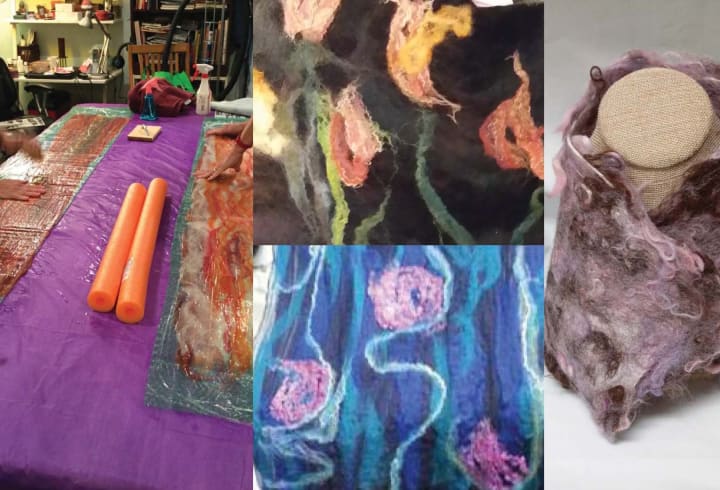
My stash of yarn and fiber never seems to get any smaller. I still receive fleece from friends and I still take joy in spinning each fleece because each one produces a unique yarn.
When I was a little girl my Scottish babysitter taught me how to knit, crochet and embroider. Since she was Scottish, and frugal, she also taught me how to darn socks. I am so grateful that she passed on her talent to me. Handwork skills, like spinning and knitting, help us to foster a connection with our ancestors. Handwork is universal and connects us with others all around the world. I have spun yak from the Himalayas, cashmere from Vermont, alpaca from Michigan, Shetland wool from New York and much more. While I spin I try to gratefully envision the person who cared for the animal that produced the fleece. Handwork is also very therapeutic; the hands are engaged but the mind is free to process and unwind. Best of all, I enjoy wearing something that I have created; after all, who doesn't like to have a one of a kind item to add to their wardrobe and have someone ask, "where did you get that?!"

About the Creator
Mary Chris Foxworthy
Mary Chris combines her life-long love affair with horses with a passion for keeping history alive. She is an active competitor at horse shows and is known for her work as a research writer for the Equine Heritage Institute.

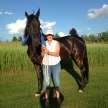





Comments (1)
Nice article, images, and designs. Well done on top story.